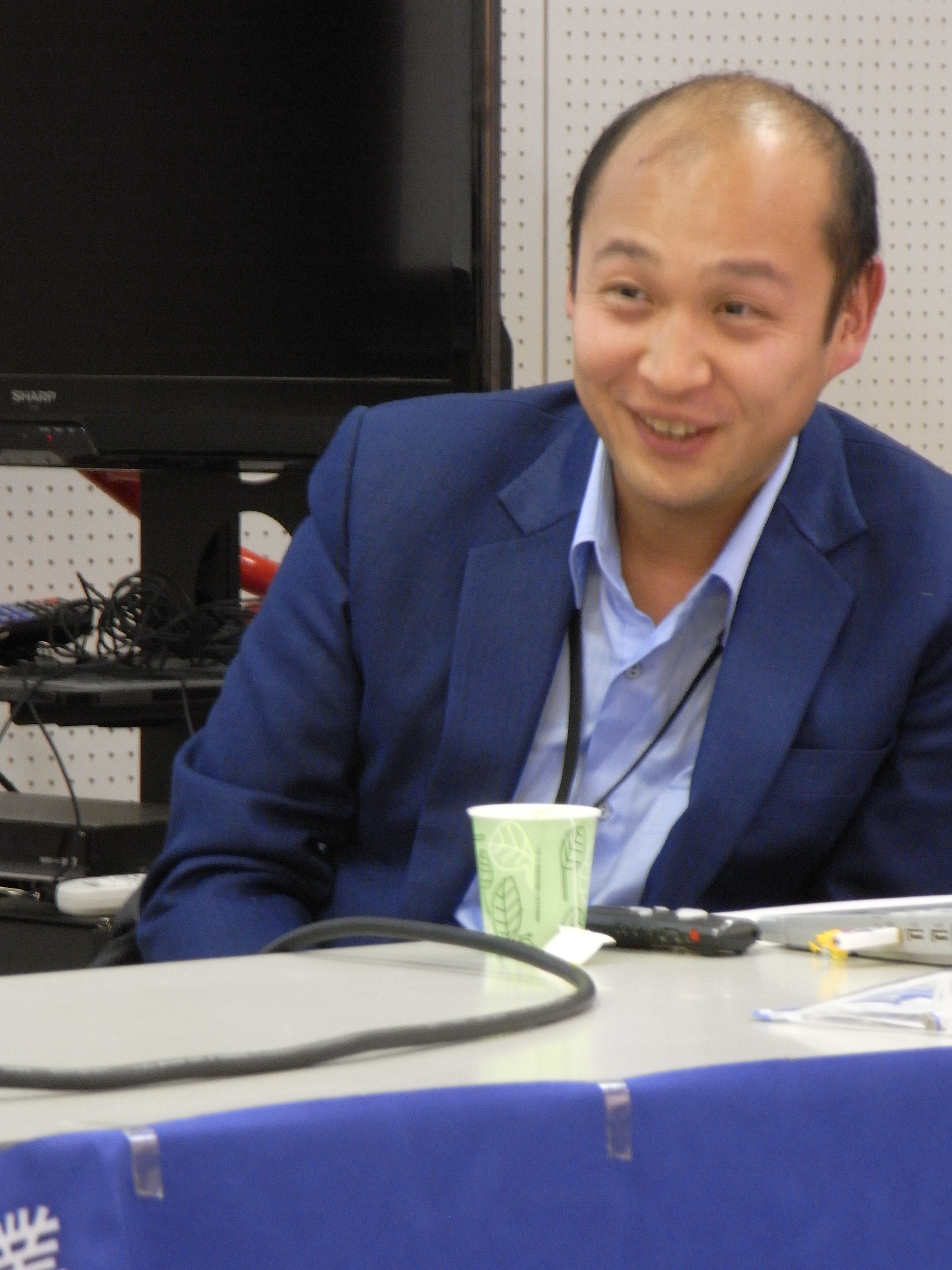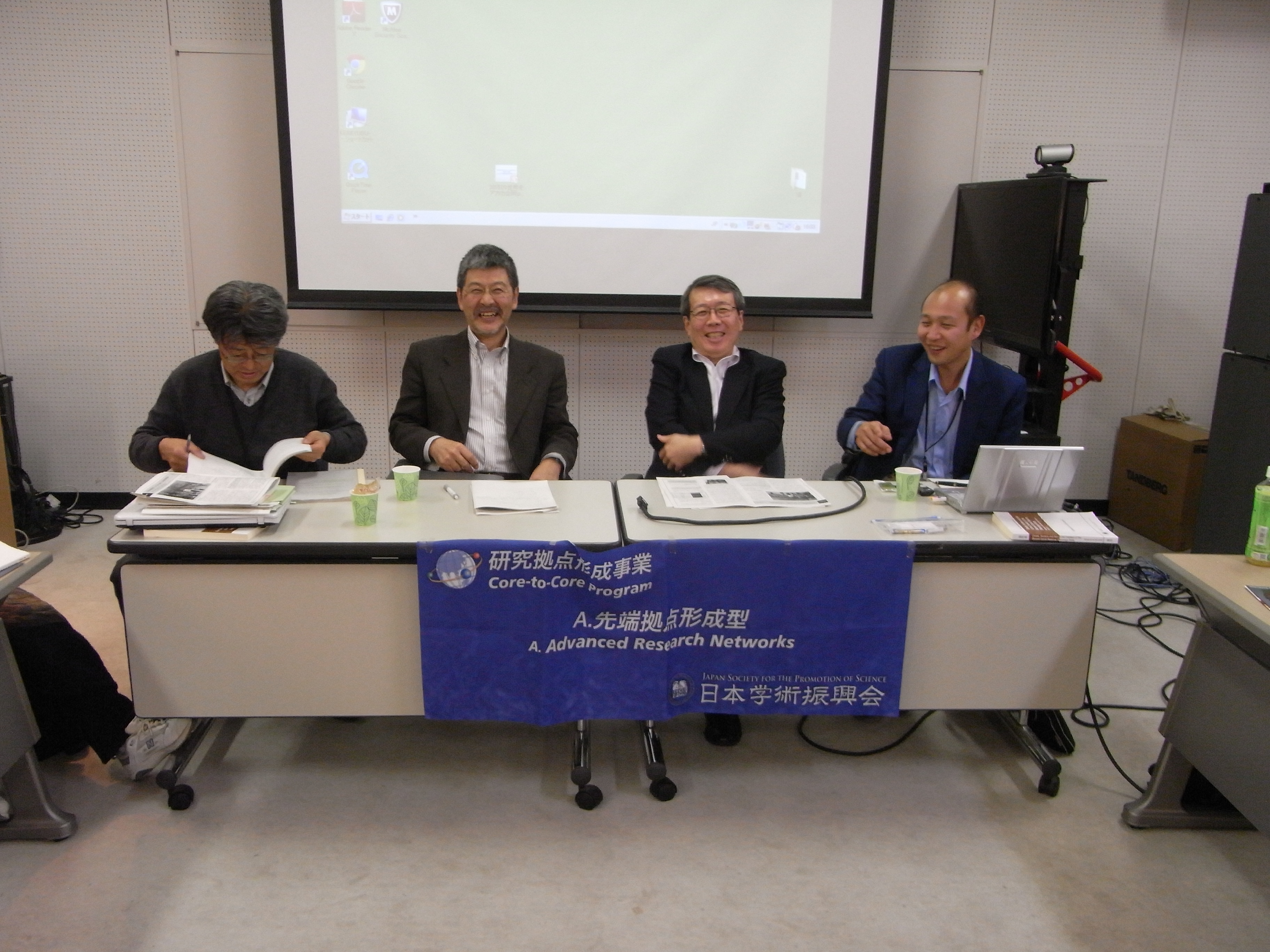2015.01.26
「世界のなかのアフリカ史」合同研究会 Africa as a Global History
2015年1月25日(土)国立民族学博物館において、「世界の中のアフリカ史の再構築」(代表竹沢尚一郎氏)との合同研究会、「世界の中のアフリカ史」研究会が開催された。この合同研究会の目的は、これまでGHCのメンバーの間でも十分に議論されてこなかった「アフリカ史」を「新しい世界史」の中でどのように叙述すべきなのかを考えるということにあった。GHC側、「世界の中のアフリカ史の再構築」側からそれぞれ2名、計4名の報告者が報告を行い、最後におよそ1時間の総合討論の場が持たれた。
羽田正「新しい世界史とグローバルヒストリー」
冒頭にGHC代表羽田正氏による基調報告が行われた。氏は、日本の学界で「グローバルヒストリー」という言葉が、また海外の学界で global history という言葉がどのような意味で用いられているのかを整理し、GHCが目指す「新しい世界史」とどこが違うのかを説明した(「新しい世界史」≒「グローバルヒストリー」≠ global history)。その上で、日本人の世界史の書き方の問題点を指摘し、地球人というアイデンティティを創出するために地球人の歴史を書く必要性、およびその手法を説いた。質疑応答では、地域区分を取り払った「新しい世界史」の中ではそれぞれの地域をどのように表現すればよいのか、「新しい世界史」をどのように誰を対象に叙述していくのか、また地球人という概念は妥当なのか、など様々な質問が寄せられ、今後拠点形成事業を進めていく上で有意義な議論が交わされた。
竹沢尚一郎「9-10世紀の西アフリカで出土した中国製陶磁:考古遺物から見たグローバルヒストリー」
続く「世界の中のアフリカ史の再構築」代表竹沢尚一郎氏による研究報告は、マリ共和国ガオ市における発掘調査の成果から、既存の西アフリカ史叙述を書き直し、世界史の中に位置付けるという趣旨のものであった。これまでの西アフリカ史叙述の主要な典拠とされてきたのは、アラビア語史料(8-16世紀)、および欧米語史料(15世紀以降)という他者の視点から叙述されたもので、その中で、アフリカは内的な発展能力を持たない客体として叙述されてきた。氏は、これに対して、考古遺物を主要典拠として、イスラーム以前よりサハラ縦断交易が行われ、国家が成立していたこと、そして、15世紀に至るまで発展を続けており、停滞に陥ったのはそれ以降のことであることを明らかにした。質疑応答では、ヨーロッパやアフリカ/西アフリカといった地域設定の問題から、本報告では言及されなかった気候変化についても考慮すべきでないかといった点まで、様々な問題提起が行われた。
(文責:大塚修)
池谷和信「アフリカの環境史:象牙、ダチョウの羽、キツネの毛皮」
池谷和信氏(民族学博物館・総合研究大学院大学)は、19世紀から20世紀前半を対象として、アフリカ南部のイギリス保護領ベチュワナランドにおける環境と社会をとりあげて、自身のこれまでの研究内容を紹介した。そのうえで、新しい世界史像を構築するために、「地域」「大陸」「世界」という空間的なスケールのバランスを意識しつつ、生き物と人とのかかわりに注目して環境史と交易史を統合する構想を提起した。フロアからは、池谷氏の構想に対して綿布の世界史と重なる部分があり興味深いとの感想を得た。また、「(アフリカ)大陸」という枠組みを疑問視する意見に対して、池谷氏は、厳密性を欠くのはたしかだが他地域との比較を容易にするのに有効であると回答した。
鈴木英明「世界史を考えるうえでの海域史の可能性と限界:インド洋海域史を事例にして」
鈴木英明氏(長崎大学)は、世界史を構想する際にはミクロとマクロの連動を見なくてはならないとして、その観点から「インド洋海域世界」という地域の設定を再検討した。「インド洋海域世界」という概念は、ネットワークの広がりを十全に包括できていないなど、元来の企図に反して固定的な領域性と隔ての作用をもつ。このような側面を克服するために、鈴木氏は、生業・移動・交換のリズムが連動する人々の集合体と、生活文化の共通性と類似性とをもって、「インド洋海域世界」を再定義することを提起した。フロアからは、領域性の強調は絶対悪なのか、や、女性や家族はどのように関わってくるのか、といった質問が寄せられた。
総合討論
総合討論の冒頭で、竹沢氏はこれまでの議論をまとめるかたちで、①世界の切り分け単位をどのように設定するか、②関係性をどのようにあつかうか、の2点に論点を整理した。総合討論では①、とくに「アフリカ」という単位で歴史を考えることについて議論が集中した。たとえば、どの時代でも「アフリカ史」が書けると考える必要はない、単位の設定は歴史を書く目的やオーディエンスに依る、ヨーロッパによるアフリカの収奪に対する批判的視点は残したい、などの発言があった。そのほか、歴史とアイデンティティの関係についても議論が交わされた。
(文責:内田力)
A research meeting titled “Africa as a Global History” was held jointly with a study group “Reconstruction of African History in a Global Context” (representative Shoichiro Takezawa) at the National Museum of Ethnology (Suita, Japan) on Saturday, January 25, 2015. The purpose of this joint meeting was to discuss how African history should be described within “new world history,” a topic which has not been sufficiently deliberated among GHC members. The meeting featured reports from two presenters each from the GHC and the “Reconstruction of African History in a Global Context” study group, followed by a one-hour general discussion session.
HANEDA Masashi: “New World History and Global History”
The joint meeting began with a keynote presentation from Masahi Haneda representing the GHC. He explained how the terms “gurobaru hisutori (the Japanese version of global history)” and “global history” are used in Japan and in the international academic community, respectively, and how these differ from the “new world history” pursued by the GHC (i.e. new world history ≒ gurobaru hisutori ≠ global history). Based on this, Haneda pointed out the challenges of world history written by Japanese scholars and discussed the need to write a history of “earth people” and to develop methodologies for doing so if we are to create an identity as “earth people.” Various questions were raised during the Q&A session that followed, including how regions should be addressed in a “new world history” that does away with regional divisions, how and for whom “new world history” should be written, and whether or not the concept of “earth person” is appropriate. A fruitful exchange of ideas was carried out in terms of proceeding with activities of the GHC.
TAKEZAWA Shoichiro: “Excavation of Chinese Porcelain from 9~10th-century Site in West Africa: Gurobaru hisutori as seen through archaeological artifacts”
The gist of the next report from Shoichiro Takezawa, representing the “Reconstruction of African History in a Global Context” study group, was to rewrite the existing descriptions of West African history and to place it in the context of the world history based on the results of an archaeological excavation in Gao City in the Republic of Mali. Up to this point, the main sources of West African history included historical records written in Arabic (8th to the 16th century) and Western languages (15th century and after), in which Africa is described as an object without any intrinsic capacity for development. In contrast to this view, using archaeological artifacts, Takezawa demonstrated that trans-Saharan trade existed prior to the introduction of Islam and that nations were established and continued to develop up to the 15th century and only began stagnate after that point. Various issues were brought up during the Q&A session, including problems related to the demarcation of regions including Europe and Africa/West Africa as well as the need to consider climate change, which was not referred to in the presentation itself.
(Osamu OTSUKA)
IKEYA Kazunobu: “Environmental History in Africa: Elephant tusks, ostrich feather and fox fur”
Kazunobu Ikeya (National Museum of Ethnography/Graduate University for Advanced Studies) introduced his own research up to this point on the environment and society of the British protectorate of Bechuanaland in southern Africa in the 19th and first half of the 20th centuries. Thereafter, he proposed a plan for integrating environmental and trade history in the creation of a new world history by focusing on the relationship between animals and people while also being conscious of balance in spatial scales ranging from region, to continent, to world. From the floor, the opinion was expressed that Ikeya’s plan was interesting due to its overlap with the world history of cotton fabric. In addition, in response to a comment questioning the use of the framework of the “African Continent,” Ikeya explained that, while such a framework may lacks in academic rigor, it is nonetheless useful when comparing Africa with other regions.
SUZUKI Hideaki: “The Potential and Limitations of Maritime History in World History: The Indian Ocean Maritime History”
Hideaki Suzuki (Nagasaki University) examined the region defined as the “Indian Ocean Maritime World,” from the standpoint that it is necessary to investigate both micro- and macro-movements when creating a world history. The concept of the “Indian Ocean Maritime World” entails both a fixed regionality and partitioning. The idea of the spread of the network has not yet been comprehensively understood. In order to overcome these issues, Suzuki proposed redefining the “Indian Ocean Maritime World” based on the collections of people responsible for creating the rhythms related to livelihood, migration, and exchange as well as the sharing of and similarities in everyday culture. Questions raised by the audience included whether or not it was absolutely wrong to emphasize regionality and how women and families would fit into this concept.
General discussion
At the start of the general discussion, Takezawa summarized the discussion up to that point into two points: (1) what units should be used to divide up the world, and (2) how relationality should be handled. The general discussion focused on point (1), and particularly how to think of the history of the unit called “Africa.” Various opinions were forwarded during the discussion, including the fact that there is no need to think that “African history” can be written for all time periods, that the setting of the unit of study depends on the purpose of the history and the audience, and that it is desirable to retain a critical view of European exploitation of Africa. In addition, the relationship between history and identity was also discussed.
(Chikara UCHIDA)

















